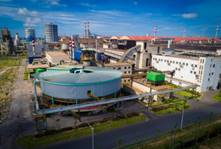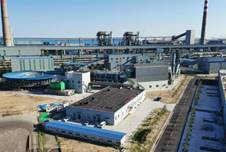Specialised Topic: CISDI’s state-of-the-art RHF tech - creating greener steel
Date:2021/9/23 Source: CISDI
Over 80 per cent of the Chinese market has now been supplied with CISDI’s rotary hearth furnaces, making the company China’s first total solutions provider for iron-bearing solid waste treatment centres.
Two rotary hearth furnaces, built by CISDI to an EPC mode, went operational in China in July.
CISDI Thermal Engineering and Environmental Protection Co. is a specialist in consulting, design, supply, EPC-based and ops management services for metallurgical thermal engineering, environmental-protection thermal power and solid and gas waste treatment.
It is the first company to recommend the centralised treatment of steel plant iron-bearing solid waste, and also the only provider of these total solutions in China.
Steel plants with centralised treatment centres can achieve zero solid waste discharge and recycle all their iron, zinc and carbon-bearing resources.
The company is also expert at rotary hearth furnace, homogenising, cold briquetting, sludge drying and hazardous waste incineration technologies, all of which contribute greatly to green and clean production.
CISDI Thermal Engineering and Environmental Protection is a quality full-process service provider, from environmental consulting, engineering design, equipment manufacturing to systematic control, technical assistance for production and ops management.
In 2009, the company set up a team dedicated to the task of systematically approaching rotary hearth furnace-based dezincification.
The team has achieved continual innovations in a cluster of RHF-related technologies - homogenising, cold briquetting and sludge drying.
Iron-bearing solid wastes are homogenised, formed, dried and reduce-roasted; zinc-bearing sludges of various compositions created throughout all procedures from ironmaking to steelmaking are treated and recycled.
The company’s unique rotary hearth furnace developments can separately recover iron and zinc from the zinc-bearing sludges.
All zinc-bearing wastes are turned into resources.
The recovered zinc powder is a quality zinc product which can be sold. Recovered iron returns to ironmaking as raw material for quality smelting. Steam generated from the treatment is recovered and utilised as energy.
Zero discharge of iron-bearing solid waste
The mainstream use of waste galvanised sheets as a raw material for BOF melting is causing an increase of zinc content in dusts and sludges.
In addition, a higher percentage of scrap is also charged into the BOF for melting. The dusts and sludges from these melting processes feature a high content of zinc and lead. Reusing these wastes for production impairs the ironmaking equipment’s service life and hampers operation.
A new process for the recovery of these iron and zinc-bearing wastes needed to be found.
CISDI’s RHF total solutions improve dezincification efficiency to over 85 per cent and almost totally recover the iron element, achieving a final product metallisation ratio of more than 75 per cent.
Environmental pollution caused by conventional landfill is eradicated and the impact of ineffective recovery on production is negated.
Applying RHF tech to an integrated steel plant reduces consumption of iron-bearing raw materials by returning the metallised pellet and powder products into the blast furnace. There are increased economic benefits, as the ZnO powder product can be sold.
The reuse or sale of the steam produced by HRSG recovery of the excess fume heat is a further economic and environmental benefit, enabling the steel plant to achieve zero iron-bearing waste discharge.
CISDI has applied for 67 patents of RHF-based products, 52 of which have been granted, including 10 patents for invention. Two computer software copyrights have also been awarded.
RHF tech leader ? over 80 per cent of the Chinese market share
CISDI Thermal Engineering and Environmental Protection Co. is making great strides in converting steel production to greener processes.
It has now built nine rotary hearth furnaces - at Yanshan Steel, Baosteel Zhanjiang, Shanghai and Wuhan, Shougang Jingtang and Xinyu Steel.
Six RHFs are in the process of being constructed at Zenith Nantong Steel, Donghai Special Steel and several other plants.
CISDI Thermal Engineering and Environmental Protection is now China’s number one RHF supplier for both as-built and in-process quantities.
Its standardised RHF products range from annual capacities of 100,000 tonnes, 150,000 tonnes, 200,000 tonnes to 250,000 tonnes and 300,000 tonnes. They account for over 80 per cent of the Chinese market share.
Star RHFs
✧ The solid waste centralised treatment centre at Baosteel Zhanjiang
Plant-wide solid wastes from the Zhanjiang complex feature very complicated compositions and varied moisture contents.
Based on massive data analysis of the iron-bearing waste quantity, source procedure, variety and composition, CISDI proposed a world-first as a solution - the first centralised treatment centre of its kind.
The centre has two RHF production lines, each requiring 200,000 tonnes a year, one homogenising line with an annual capacity of 800,000 tonnes, one cold briquetting line with an annual capacity of 100,000 tonnes, and one scale separation line with an annual capacity of 200,000 tonnes.
Phase 1 of construction was started up in June 2016 and all lines were completed, with the exception of one of the RHFs during Phase 2, which was started up in April 2021.
All lines ramped up to their projected treatment capacities on schedule and to quality targets. All systems and equipment are running stably and smoothly.
An integration of CISDI’s four critical solid waste treatment technologies, the centre removes the impact of hazardous impurities and ensures all related procedures operate more smoothly and to greener standards.

The solid waste centralised treatment centre helping to create a greener Baosteel Zhanjiang
✧ Waste to energy project at Shougang Jingtang Steel
CISDI built a homogenising line with an annual capacity of 150,000 tonnes and a RHF line with an annual capacity of 300,000 tonnes at Shougang Jingtang Steel. The build followed a comprehensive analysis of the internal iron-bearing waste’s quantity, storage capacity, variety and composition.
The homogenising line blends oily sludge with a high moisture content from the hot rolling production with low-zinc dry dusts, which can then be regenerated as a resource.
Production began in April 2020 and reached its designed capacity in the first month after start-up.
The RHF line transforms dusts from blast furnace ironmaking’s cyclone dedusting and from BOF steelmaking’s primary and secondary dedusting into resources. It began operation three months after the homogenising line and its performance indicators have seen steady improvements.
Jingtang Plant is the first application of CISDI’s standardised 300,000-tonne RHF product. All iron traces are being removed from the plant’s solid waste.

Waste to energy facilities at Shougang Jingtang Steel

